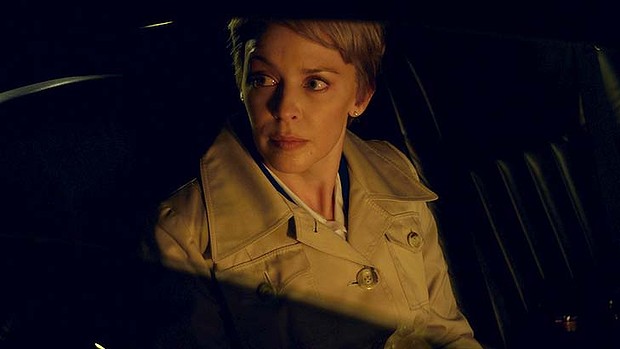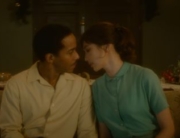
Kyle Minogue in HOLY MOTORS (Indomina Releasing)
![]() Leos Carax has returned in a big way with Holy Motors, an astonishing, unclassifiable free-form fantasia, a fever dream of cinema that seems to reinvent itself with each scene. Carax dips into many genres—science fiction, gangster movies, film noir, musicals—investing it with a general bizarreness that will enchant as many viewers as it will confound and frustrate. But what’s undeniable is that Carax has created a masterwork that both celebrates and eulogizes cinema. It’s not only about cinema (among many other things), it is cinema. Carax’s grand vision opens one’s eyes to the potential of what movies can uniquely do, which most filmmakers fail to explore.
Leos Carax has returned in a big way with Holy Motors, an astonishing, unclassifiable free-form fantasia, a fever dream of cinema that seems to reinvent itself with each scene. Carax dips into many genres—science fiction, gangster movies, film noir, musicals—investing it with a general bizarreness that will enchant as many viewers as it will confound and frustrate. But what’s undeniable is that Carax has created a masterwork that both celebrates and eulogizes cinema. It’s not only about cinema (among many other things), it is cinema. Carax’s grand vision opens one’s eyes to the potential of what movies can uniquely do, which most filmmakers fail to explore.
This is only his fifth feature in his nearly three decade career and his first in 13 years (his last was 1999’s Pola X). But what Carax lacks in prolificacy, he more than makes up for in audacity, invention, and sheer fearlessness in following wherever his muse takes him. He is best known for the wild and grandly romantic Lovers on the Bridge, his 1991 feature which was an ambitious, big film with big ideas, but which was a massive financial failure that nearly ended his career. Indeed, in the 20 years since that film, Carax’s only cinematic output besides Pola X was the short “Merde,” part of the 2008 omnibus film Tokyo!
Holy Motors gives the impression of a deeply personal film for its creator; reinforcing this is the fact that Carax appears in the opening scene. The film begins with the image of a cinema audience with their eyes closed, either asleep or dead; the movie playing in front of them is King Vidor’s The Crowd (1928). We then see Carax awakening, emerging from his bed, and finding a secret passage in his bedroom that leads to the theater. It has been said that watching a film is like dreaming with one’s eyes open; here Carax directly connects the act with a dream state. Carax stands in the balcony, staring at the screen, on which is perhaps the very movie that follows this scene.
Thereafter, we follow the adventures of Mr. Oscar, played by Carax’s frequent star, the inimitable Denis Lavant. Holy Motors, among its great virtues, is a fantastic showcase for the immense talent and versatility of this acrobatic and fearless actor, whose work here leaves one with astonishment. Mr. Oscar first emerges from a large house, waving goodbye to his children. He’s apparently an important businessman flanked by security guards, and is picked up by a long, white limousine chauffeured by Céline (Édith Scob), who will take him to his “appointments” for the day. After chatting on the phone about stock quotes and beefing up the weaponry for his security, he does a very odd thing: he sets up a lighted mirror, the kind that actors use for putting on makeup. He then transforms himself with prosthetics into the polar opposite of the captain of industry he first appears to be: an old woman who begs for change on a bridge over the river Seine.
These assignations consist of Mr. Oscar putting on personas over the course of a single day. Like a snake shedding skin, he turns into different people and lives one life for a time. Holy Motors, therefore, has a very episodic structure in which one scene leads to another with dream logic, instead of a normal dramatic construction. At various points, Monsieur Oscar becomes a feral satyr in a leprechaun-like outfit (reprising the character Lavant played in “Merde”) who kidnaps a fashion model (Eva Mendez), taking her to an underground lair in the sewers; and later a man who meets an old flame (Kylie Minogue) on the roof of a department store about to be torn down, where the woman sings a song about their life together before death pays a call. And Mr. Oscar is not alone in his act of putting on personas; a couple of other people he meets along the way are also involved in this odd profession, run by an agent (Michel Piccoli).
What this all ultimately means is beautifully, and exhilaratingly, left wide open for our interpretation. The title itself may provide a clue; Carax seems to be both fascinated by and fearful of technology. The digital gadgetry we have surrounded ourselves with have made us to, a large extent, a combination of human and machine; there is a part of our soul that may have died with this change, and death permeates Holy Motors. It’s dedicated to Carax’s companion, Yekaterina Golubeva, who starred in his previous film Pola X and who passed away last year. She was also the mother of his seven-year-old daughter, who appears briefly in the film’s opening.
Identity is portrayed as an endless succession of death and rebirth, where the idea of the human as an individual no longer seems to exist. But this is not as pessimistic an idea as it sounds. Carax finds great artistic possibilities in this digitalized existence and a freedom in the exploding of rigidly defined identities. Holy Motors also invokes the ghosts of cinema past (Vidor; Georges Franju’s Eyes Without a Face—Édith Scob dons a mask similar to the one she wore in that film; Lon Chaney’s man of a thousand faces) to create a work that is gloriously alive.
















Leave A Comment